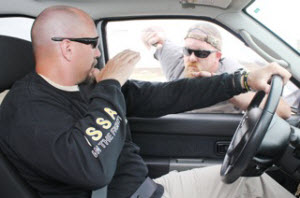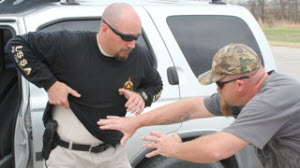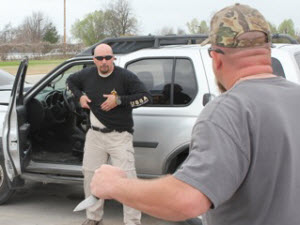
Not knowing how to employ a firearm from positions other than standing comes from a failure to explore those concepts in training.
www.personaldefensenetwork.com
Drawing at this distance, no matter how fast, may not work. The average concealed carry holder might not know this, which is why training is so important.
www.personaldefensenetwork.comUnfortunately, at USSA we have found that only 30% of our graduates return for a follow-on class in the first year. I hope that if you are reading this, you aren’t one who will never return for a follow-up class, but if you are, I warn you: Your chances on the street are slim to none if you come up against a hardened opponent! Get some additional training.
Q&A: Fighting with a Handgun
Let’s discuss some truths about fighting with a handgun. First, answer yes or no to the following questions (for this particular scenario, assume that you have made the decision to use lethal force based on your particular state laws):
Let’s discuss some truths about fighting with a handgun. First, answer yes or no to the following questions (for this particular scenario, assume that you have made the decision to use lethal force based on your particular state laws):
When dealing with a potential threat more than three yards away, can you access and draw your firearm efficiently and quickly (under two seconds), and do you practice those techniques weekly (at a minimum)?
If you were forced to deal with that same threat and they were less than three yards away, do you know what to do in that close proximity? What if that same threat were so close (less than a yard) that they could grab or punch you? Would you know how to handle that situation, i.e., could you protect yourself against the punch?
If you were seated in your vehicle, seat-belted in, would you know how to deal with a threat?
During your critical incident, if you drew and shot the threatening person yet they failed to stop, would you know how to handle that or what caused it? If you were injured or one of your hands was occupied during a critical incident, could you still draw, reload, and clear malfunctions in your handgun with one hand?
If cover was available, could you use it efficiently and still return fire?
During your incident, you might experience some physiological and psychological effects that could easily rattle you. Do you know what to expect? Lastly, have you ever exposed yourself to stress that simulates a real fight, and if not, do you know what it will be like?
Thanks
If you are reading this, you are probably a current or former law enforcement officer, member of the military, or law-abiding citizen who takes responsibility for protecting yourself and others. To those who are or have been in the military or law enforcement, I would like to say thank you for your service. And to those civilians, thank you for stepping up to the plate and preparing to protect the weak and innocent. God knows we need people like all of you during these times. There are two types of people out there: those who will actually stand up for what is right, and those who like to talk about doing the right thing but complain about how a police officer, military member, or citizen in a self-defense situation acted too violently. Thanks for being one of those who stand up for what is right!

Specialty subjects like this one-handed draw process are critical skills a warrior must have to potentially win a fight.
www.personaldefensenetwork.comResponsibility
I have met countless police officers and members of the military who believe that the skill level they have when they leave the academy or boot camp is enough to save their lives — just like the concealed carry graduate who thinks their certificate to carry will be all they’ll need when something bad happens. I say NO! The first thing I would challenge anyone who works in the fields of warriorship to do is take responsibility for their own survival. Give your time and, yes, your money to train in your combative skill sets as much as you can. I despise the “I don’t have time to train” and “my agency does not give me enough ammunition to practice with” attitudes. If you think that way, slap yourself silly — and then start to take responsibility for your own survival. TRAIN LIKE YOUR LIFE DEPENDS ON IT!

A gunfight may start like this. An assault is not always clear, and physical violence may precede the actual gunfight. Fighting fitness and proper training are musts in this situation, and never addressed in most concealed carry classes.
www.personaldefensenetwork.comFighting Fitness
I spend a good deal of time around guys who are good with guns. One comment I often hear is, “I don’t need to be in good enough shape to run — I’ll just shoot him!” This answer may be in response to a question about how much time the person spends doing cardiovascular work (running is the most common) to enhance their ability to fight. To those who say they aren’t concerned about their fitness level, I doubt they have been in a real fight for their life. Fitness is everything in a fight, especially for those who work in close proximity to their opponents. A sniper may be able to stop the fight from a distance, but most other fights will eventually end up with some sort of close contact.
Even if we don’t have to rely on our fitness level from a physical standpoint, I have never heard of a person in a gunfight with a resting (normal) heart rate. A high level of fitness will allow a warrior to be more effective with all of their weapon systems, because their heart rate will be lower and their body will be able to handle more stress. Most gunfights are running fights, and a warrior must be very fit to survive these circumstances. If you consider yourself to be a warrior, get yourself to the gym. Spend time developing cardiovascular fitness as well as strength and flexibility.

Effective use of cover may save your life, but most graduates of a carry class with no other training will not know the techniques behind selecting and using cover unless they continue to train after their carry permit class.
www.personaldefensenetwork.comSpecialization
Don’t specialize! When designing your training, schedule training sessions for each and every weapon system in your arsenal, to form a layered system that allows you to flow from one weapon to the other without hesitation. Know your rules of engagement and/or your state’s policies and laws that allow you to utilize your different weapon systems. Train yourself to flow from one tool to the next by engaging in reality-based scenarios, or at a minimum, visualize proper response to different scenarios. Spend a relatively equal amount of time training with all weapons. If you have weaknesses, take the time to fix them before they cost you your life.
Mindset
Develop a “never quit” attitude. Don’t even think about allowing yourself to quit during a drill or repetition during a training session, even if no one is looking — fight through the mistake. Visualize yourself in situations where you’re at a disadvantage, and see yourself winning the fight, even if things are really bad. See yourself getting hit and fighting through the pain to deal death or damage to your attacker. Develop that “switch,” the one that when flipped turns you into an unstoppable warrior intent on surviving by making sure your opponent does not. Accept and embrace the violence you may have to bestow upon someone before the fight happens, so that you are mentally ready when it does.
Conclusion
In closing, if you have fallen into that “trap” and have the newest gun and gear but have not spent the time and money on valuable training and preparation, please fix that now. I hope I have motivated you rather than offended you, but either way, if I help prepare you by pushing you to gain life-saving skills, then I have succeeded.


Thanks for the marvelous posting! I seriously enjoyed reading it, you can be a great author.I will always bookmark your blog and will often come back in the future. I want to encourage you to ultimately continue your great posts, have a nice day!
Where in Okla City is advanced training available? Please recommend Thanks I am a 68 year old Vietnam vet and feel I am very lacking real life self defense skills. Home and street defense is different.
Great article! I've been in many violent encounters in the past, having grown up in a very rough area when I was younger. And you are absolutely right, training should NEVER stop. Even though I'm a gun instructor, I will forever be a student as well, constantly learning, refining, and improving my skills. Some instructors get complacent, get the "I know everything" syndrome. Not me. I'm just a student who instructs.
I appreciate you taking the time and pointing out the need to work at being a warrior. I've carried guns for 35 years now. I had one encounter with some B G's. I don't think I' m ever going to get to the point I don't need practice. We can make a difference in our world. It's a mental thing too.
While I agree that training is necessary to be effective in all situations, you also imply that extensive training should be mandatory at the beginning of your article. I have a problem with this as it puts a restriction, that can not be met be a portion of the population, on a constitutional right (that "not be infringed" thing). Indeed it would disarm some that need to be carrying, but can not afford to pay you for additional training. Not a fan of someone telling me I can't protect my family because I don't have $5000 for training,
Self defense is a right and I don't need some govt official telling me my I need training or som self righteous military or police horses ass saying the same.
Thanks for sharing your thoughts. I really appreciate your efforts and I will be waiting for your further write ups thanks once again.
As a former deputy sheriff (career ended after enduring a gunshot wound to the body) along with having been a bail agent in the Los Angeles area ending up in a clean shooting of two gang members in the middle of the night, my comment goes as follows: Even after college training and the police academy you are not complete on being ready. You must regularly train and re-train constantly. Even after re-training you are not knowing that every situation is different. This knowledge of self defense is always on the learning. The shooting must be practical for not only physical self defense, but also for legal and emotional self defense as well. God Bless all who tries as I on being a guardian of defending others along with yourself. James E. Hall
I'm going on 78, and the running part is out. My knees just won't take the jarring. I work out five days a week at the gym, though, both walking and strength training, and I hope if a bg tackles me, I won't be quite the old, helpless target he expected. I also practice with my EMP 9mm as often as I can.
I just have one caveat... Time will erode your ability to act and react. At 63 (and counting) I have gone through the "bell" curve in the physical abilities. Now I am on the "down" slope. When I was 40 I found out - the hard way - what Mr. Calendar can do to those who still think are 20-ish. I jumped over a fence and almost made it. The tip of my trailing foot did not make it in time and I had a sudden encounter with the pavement. As great, true and effective the provided information is; and as hugely important practice becomes to us who carry, consider the fact that we are not getting any younger. If unable to use my firearm, I will slash, bite, spit, gouge, scream and kick 'till I win or my attacker flees. I read somewhere that "the one that stays in the fight longer, usually wins." Yes, train hard and often. Keep in shape. Be aware of your surroundings. But fight to win - always. Just saying...